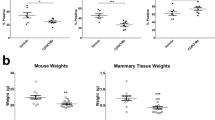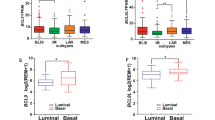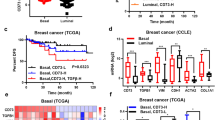Abstract
CD200 acts through its receptor (CD200R) to inhibit excessive inflammation. The role of CD200-CD200R1 interaction in tumor immunity is poorly understood. In this study, we examined the role of CD200-CD200R1 interaction in the progression and metastasis of highly aggressive 4THM murine-breast carcinoma using CD200 transgenic (CD200tg) and CD200R1 knock-out (CD200R1−/−) BALB/c mice. 4THM cells induce extensive visceral metastasis and neutrophil infiltration in affected tissues. CD200 overexpression in the host was associated with decreased primary tumor growth and metastasis, whereas lack of CD200R1 expression by host cells was associated with enhanced visceral metastasis. Absence of CD200R1 expression led to decreased tumor-infiltrating-cytotoxic T cells and increased the release of inflammatory cytokines, such as tumor necrosis factor-α (TNF-α) and interleukin (IL)-6. In contrast, CD200 overexpression led to increased tumor-induced interferon-γ and IL-10 response and decreased TNF-α and IL-6 release. Neutrophil infiltration of tissues was markedly decreased in CD200tg animals and increased in CD200R1−/− mice. These findings are contradictory to what has been reported in the EMT6 mouse breast-cancer model. Other distinguishing features of tumor elicited by EMT6 and 4THM cell injections were also examined. Visceral tissues from mice bearing EMT6 tumors showed a lack of neutrophil infiltration and decreased IL-6 release in CD200R1−/− mice. EMT6 and 4THM cells also differed in vimentin expression and in vitro migration rate, which was markedly lower in EMT6 tumors. These results support the hypothesis that CD200 expression can alter immune responses, and can inhibit metastatic growth of tumor cells that induce systemic and local inflammatory response. Increasing CD200 activity/signaling might be an important therapeutic strategy for treatment of aggressive breast carcinomas.
This is a preview of subscription content, access via your institution
Access options
Subscribe to this journal
Receive 50 print issues and online access
$259.00 per year
only $5.18 per issue
Buy this article
- Purchase on Springer Link
- Instant access to full article PDF
Prices may be subject to local taxes which are calculated during checkout





Similar content being viewed by others
References
Wright GJ, Puklavec MJ, Willis AC, Hoek RM, Sedgwick JD, Brown MH et al. Lymphoid/neuronal cell surface OX2 glycoprotein recognizes a novel receptor on macrophages implicated in the control of their function. Immunity 2000; 13: 233–242.
Gorczynski R, Chen Z, Kai Y, Lee L, Wong S, Marsden PA . CD200 is a ligand for all members of the CD200R family of immunoregulatory molecules. J Immunol 2004; 172: 7744–7749.
Wright GJ, Cherwinski H, Foster-Cuevas M, Brooke G, Puklavec MJ, Bigler M et al. Characterization of the CD200 receptor family in mice and humans and their interactions with CD200. J Immunol 2003; 171: 3034–3046.
Boudakov I, Liu J, Fan N, Gulay P, Wong K, Gorczynski RM . Mice lacking CD200R1 show absence of suppression of lipopolysaccharide-induced tumor necrosis factor-alpha and mixed leukocyte culture responses by CD200. Transplantation 2007; 84: 251–257.
Gorczynski RM, Chen Z, Hu J, Kai Y, Lei J . Evidence of a role for CD200 in regulation of immune rejection of leukaemic tumor cells in C57BL/6 mice. Clin Exp Immunol 2001; 126: 220–229.
Kretz-Rommel A, Qin F, Dakappagari N, Cofiell R, Faas SJ, Bowdish KS . Blockade of CD200 in the presence or absence of antibody effector function: implications for anti-CD200 therapy. J Immunol 2008; 180: 699–705.
Memarian A, Nourizadeh M, Masoumi F, Tabrizi M, Emami AH, Alimoghaddam K et al. Upregulation of CD200 is associated with Foxp3+ regulatory T cell expansion and disease progression in acute myeloid leukemia. Tumor Biol 2013; 34: 531–542.
Wong KK, Brenneman F, Chesney A, Spaner DE, Gorczynski RM . Soluble CD200 is critical to engraft chronic lymphocytic leukemia cells in immunocompromised mice. Cancer Res 2012; 72: 4931–4943.
Rygiel TP, Karnam G, Goverse G, van der Marel AP, Greuter MJ, van Schaarenburg RA et al. CD200-CD200R signaling suppresses anti-tumor responses independently of CD200 expression on the tumor. Oncogene 2012; 31: 2979–2988.
Stumpfova M, Ratner D, Desciak EB, Eliezri YD, Owens DM . The immunosuppressive surface ligand CD200 augments the metastatic capacity of squamous cell carcinoma. Cancer Res 2010; 70: 2962–2972.
Colmont CS, Benketah A, Reed SH, Hawk NV, Telford WG, Ohyama M et al. CD200-expressing human basal cell carcinoma cells initiate tumor growth. Proc Natl Acad Sci USA 2013; 110: 1434–1439.
Talebian F, Liu JQ, Liu Z, Khattabi M, He Y, Ganju R et al. Melanoma cell expression of CD200 inhibits tumor formation and lung metastasis via inhibition of myeloid cell functions. PLoS One 2012; 7: e31442.
Hanahan D, Weinberg RA . Hallmarks of cancer: the next generation. Cell 2011; 144: 646–674.
Bao L, Haque A, Jackson K, Hazari S, Moroz K, Jetly R, Dash S . Increased expression of P-glycoprotein is associated with doxorubicin chemoresistance in the metastatic 4T1 breast cancer model. Am J Pathol 2011; 178: 838–852.
Erin N, Akdas BG, Harms JF, Clawson GA . Vagotomy enhances experimental metastases of 4THMpc breast cancer cells and alters substance P level. Regul Pept 2008; 151: 35–42.
Erin N, Zhao W, Bylander J, Chase G, Clawson G . Capsaicin-induced inactivation of sensory neurons promotes a more aggressive gene expression phenotype in breast cancer cells. Breast Cancer Res Treat 2006; 99: 351–364.
Erin N, Wang N, Xin P, Bui V, Weisz J, Barkan GA et al. Altered gene expression in breast cancer liver metastases. Int J Cancer 2009; 124: 1503–1516.
Erin N, Kale S, Tanriover G, Koksoy S, Duymus O, Korcum AF . Differential characteristics of heart, liver, and brain metastatic subsets of murine breast carcinoma. Breast Cancer Res Treat 2013; 139: 677–689.
Gorczynski RM, Clark DA, Erin N, Khatri I . Role of CD200 expression in regulation of metastasis of EMT6 tumor cells in mice. Breast Cancer Res Treat 2011; 130: 49–60.
Podnos A, Clark DA, Erin N, Yu K, Gorczynski RM . Further evidence for a role of tumor CD200 expression in breast cancer metastasis: decreased metastasis in CD200R1KO mice or using CD200-silenced EMT6. Breast Cancer Res Treat 2012; 136: 117–127.
Hoek RM, Ruuls SR, Murphy CA, Wright GJ, Goddard R, Zurawski SM et al. Down-regulation of the macrophage lineage through interaction with OX2 (CD200). Science 2000; 290: 1768–1771.
Colotta F, Allavena P, Sica A, Garlanda C, Mantovani A . Cancer-related inflammation, the seventh hallmark of cancer: links to genetic instability. Carcinogenesis 2009; 30: 1073–1081.
Dvorak HF . Tumors. wounds that do not heal. Similarities between tumor stroma generation and wound healing. N Engl J Med 1986; 315: 1650–1659.
Charafe-Jauffret E, Ginestier C, Iovino F, Wicinski J, Cervera N, Finetti P et al. Breast cancer cell lines contain functional cancer stem cells with metastatic capacity and a distinct molecular signature. Cancer Res 2009; 69: 1302–1313.
Murohashi M, Hinohara K, Kuroda M, Isagawa T, Tsuji S, Kobayashi S et al. Gene set enrichment analysis provides insight into novel signalling pathways in breast cancer stem cells. Br J Cancer 2010; 102: 206–212.
Sansone P, Storci G, Tavolari S, Guarnieri T, Giovannini C, Taffurelli M et al. IL-6 triggers malignant features in mammospheres from human ductal breast carcinoma and normal mammary gland. J Clin Invest 2007; 117: 3988–4002.
Iliopoulos D, Hirsch HA, Struhl K . An epigenetic switch involving NF-kappaB, Lin28, Let-7 microRNA, and IL6 links inflammation to cell transformation. Cell 2009; 139: 693–706.
Tamm I, Cardinale I, Krueger J, Murphy JS, May LT, Sehgal PB . Interleukin 6 decreases cell-cell association and increases motility of ductal breast carcinoma cells. J Exp Med 1989; 170: 1649–1669.
Studebaker AW, Storci G, Werbeck JL, Sansone P, Sasser AK, Tavolari S et al. Fibroblasts isolated from common sites of breast cancer metastasis enhance cancer cell growth rates and invasiveness in an interleukin-6-dependent manner. Cancer Res 2008; 68: 9087–9095.
Lin G, Wang J, Lao X, Wang J, Li L, Li S et al. Interleukin-6 inhibits regulatory T cells and improves the proliferation and cytotoxic activity of cytokine-induced killer cells. J Immunother 2012; 35: 337–343.
Lippitz BE . Cytokine patterns in patients with cancer: a systematic review. Lancet Oncol 2013; 14: e218–e228.
Storci G, Sansone P, Mari S, D'Uva G, Tavolari S, Guarnieri T et al. TNFalpha up-regulates SLUG via the NF-kappaB/HIF1alpha axis, which imparts breast cancer cells with a stem cell-like phenotype. J Cell Physiol 2010; 225: 682–691.
Wu Y, Zhou BP . TNF-alpha/NF-kappaB/Snail pathway in cancer cell migration and invasion. Br J Cancer 2010; 102: 639–644.
Geng Y, Chandrasekaran S, Hsu JW, Gidwani M, Hughes AD, King MR . Phenotypic switch in blood: effects of pro-inflammatory cytokines on breast cancer cell aggregation and adhesion. PLoS One 2013; 8: e54959.
Montagut C, Tusquets I, Ferrer B, Corominas JM, Bellosillo B, Campas C et al. Activation of nuclear factor-kappa B is linked to resistance to neoadjuvant chemotherapy in breast cancer patients. Endocr Relat Cancer 2006; 13: 607–616.
Street SE, Trapani JA, MacGregor D, Smyth MJ . Suppression of lymphoma and epithelial malignancies effected by interferon gamma. J Exp Med 2002; 196: 129–134.
Corthay A, Skovseth DK, Lundin KU, Rosjo E, Omholt H, Hofgaard PO et al. Primary antitumor immune response mediated by CD4+ T cells. Immunity 2005; 22: 371–383.
Mosser DM, Zhang X . Interleukin-10: new perspectives on an old cytokine. Immunol Rev 2008; 226: 205–218.
Erdman SE, Rao VP, Poutahidis T, Ihrig MM, Ge Z, Feng Y et al. CD4(+)CD25(+) regulatory lymphocytes require interleukin 10 to interrupt colon carcinogenesis in mice. Cancer Res 2003; 63: 6042–6050.
Kundu N, Beaty TL, Jackson MJ, Fulton AM . Antimetastatic and antitumor activities of interleukin 10 in a murine model of breast cancer. J Natl Cancer Inst 1996; 88: 536–541.
Zhang L, Conejo-Garcia JR, Katsaros D, Gimotty PA, Massobrio M, Regnani G et al. Intratumoral T cells, recurrence, and survival in epithelial ovarian cancer. N Engl J Med 2003; 348: 203–213.
Seo AN, Lee HJ, Kim EJ, Kim HJ, Jang MH, Lee HE et al. Tumour-infiltrating CD8+ lymphocytes as an independent predictive factor for pathological complete response to primary systemic therapy in breast cancer. Br J Cancer 2013; 109: 2705–2713.
West NR, Kost SE, Martin SD, Milne K, Deleeuw RJ, Nelson BH et al. Tumour-infiltrating FOXP3(+) lymphocytes are associated with cytotoxic immune responses and good clinical outcome in oestrogen receptor-negative breast cancer. Br J Cancer 2013; 108: 155–162.
Gorczynski RM, Chen Z, Diao J, Khatri I, Wong K, Yu K et al. Breast cancer cell CD200 expression regulates immune response to EMT6 tumor cells in mice. Breast Cancer Res Treat 2010; 123: 405–415.
Korsching E, Packeisen J, Liedtke C, Hungermann D, Wulfing P, van Diest PJ et al. The origin of vimentin expression in invasive breast cancer: epithelial-mesenchymal transition, myoepithelial histogenesis or histogenesis from progenitor cells with bilinear differentiation potential?. J Pathol 2005; 206: 451–457.
Gorczynski RM, Chen Z, Khatri I, Podnos A, Yu K . Cure of metastatic growth of EMT6 tumor cells in mice following manipulation of CD200:CD200R signaling. Breast Cancer Res Treat 2013; 142: 271–282.
Knutson KL, Lu H, Stone B, Reiman JM, Behrens MD, Prosperi CM et al. Immunoediting of cancers may lead to epithelial to mesenchymal transition. J Immunol 2006; 177: 1526–1533.
Ryckman C, Vandal K, Rouleau P, Talbot M, Philippe A, Tessier PA . Proinflammatory activities of S100: Proteins S100A8, S100A9, and S100A8/A9 induce neutrophil chemotaxis and adhesion. J Immunol 2003; 170: 3233–3242.
Maru Y . Which came first tumor cells or macrophages?. Cell Adh Migr 2007; 1: 107–109.
Kim H, Kang HJ, Lee H, Lee ST, Yu MH, Kim H et al. Identification of S100A8 and S100A9 as serological markers for colorectal cancer. J. Proteome Res 2009; 8: 1368–1379.
Hiratsuka S, Ishibashi S, Tomita T, Watanabe A, Akashi-Takamura S, Murakami M et al. Primary tumours modulate innate immune signalling to create pre-metastatic vascular hyperpermeability foci. Nat Commun 2013; 4: 1853.
Liu Y, Kosaka A, Ikeura M, Kohanbash G, Fellows-Mayle W, Snyder LA, Okada H . Premetastatic soil and prevention of breast cancer brain metastasis. Neuro Oncol 2013; 15: 891–903.
Gorczynski RM, Chen Z, He W, Khatri I, Sun Y, Yu K et al. Expression of a CD200 transgene is necessary for induction but not maintenance of tolerance to cardiac and skin allografts. J Immunol 2009; 183: 1560–1568.
Erin N, Boyer PJ, Bonneau RH, Clawson GA, Welch DR . Capsaicin-mediated denervation of sensory neurons promotes mammary tumor metastasis to lung and heart. Anticancer Res 2004; 24: 1003–1009.
Acknowledgements
This work was supported by funds from the TÜBİTAK (the scientific and technological research council of Turkey; project no: 109S449); Akdeniz University Research Units, Antalya, Turkey (project no: 2013.12.0103.001); and the Canadian Cancer Society (grant to RMG). We thank Nilüfer Ekinci for her technical help.
Author information
Authors and Affiliations
Corresponding author
Ethics declarations
Competing interests
The authors declare no conflict of interest.
Additional information
Supplementary Information accompanies this paper on the Oncogene website
Rights and permissions
About this article
Cite this article
Erin, N., Podnos, A., Tanriover, G. et al. Bidirectional effect of CD200 on breast cancer development and metastasis, with ultimate outcome determined by tumor aggressiveness and a cancer-induced inflammatory response. Oncogene 34, 3860–3870 (2015). https://doi.org/10.1038/onc.2014.317
Received:
Revised:
Accepted:
Published:
Issue Date:
DOI: https://doi.org/10.1038/onc.2014.317
This article is cited by
-
CD200 mimetic aptamer PEG-M49 markedly increases the therapeutic effects of pegylated liposomal doxorubicin in a mouse model of metastatic breast carcinoma: an effect independent of CD200 receptor 1
Cancer Immunology, Immunotherapy (2020)
-
Role of sensory neurons, neuroimmune pathways, and transient receptor potential vanilloid 1 (TRPV1) channels in a murine model of breast cancer metastasis
Cancer Immunology, Immunotherapy (2020)
-
NK1R antagonist decreases inflammation and metastasis of breast carcinoma cells metastasized to liver but not to brain; phenotype-dependent therapeutic and toxic consequences
Cancer Immunology, Immunotherapy (2020)
-
HSP90 inhibitor PU-H71 increases radiosensitivity of breast cancer cells metastasized to visceral organs and alters the levels of inflammatory mediators
Naunyn-Schmiedeberg's Archives of Pharmacology (2020)
-
Primary tumor-induced immunity eradicates disseminated tumor cells in syngeneic mouse model
Nature Communications (2019)



